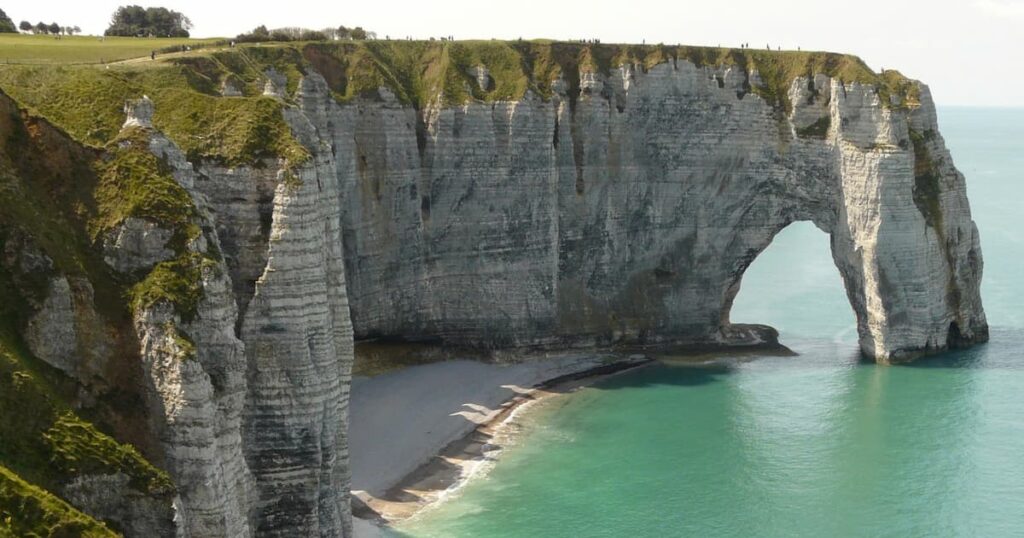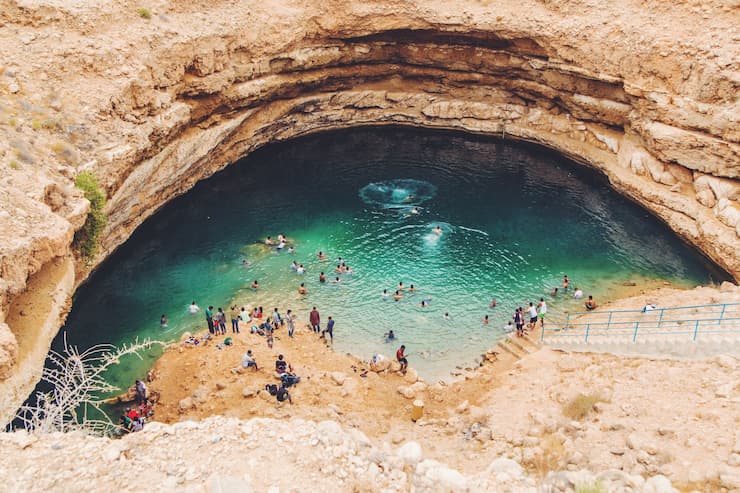Water erosion is the process by which water wears away at the surface of the Earth. It is a natural process that occurs over time, but human activities can also contribute to erosion. In this article, we are going to analyze the different types of water erosion, with some subcategories, and offer a full-scale list of real-world examples of water erosion from all around the world.

Understanding the different types of water erosion landforms is important for understanding the natural processes that shape our planet and preserving these unique and beautiful features.
Types of Water Erosion Landforms
There are several different types of water erosion landforms, including erosion caused by running water, groundwater, and wave action. Erosion by running water includes landforms such as rills and gullies, stream valleys, waterfalls, and river meanders. Erosion by groundwater includes sinkholes, caves, and springs. Erosion by wave action includes sea cliffs, beaches, sea arches, and stacks. Each type of water erosion landform is unique and has its own distinct characteristics, but they all play an important role in shaping the natural landscape.
Erosion by Running Water
- Rills and gullies are small channels created by water flowing over the land’s surface. They are often found in areas with high precipitation or steep slopes and can signify severe erosion.
- Stream Valleys are formed by the erosion of a stream or river over time. As the water flows downstream, it cuts deeper into the land, creating a valley.
- Waterfalls are created when a river or stream, such as a cliff or rock formation, flows over a step or drop in the land. The falling water erodes the rock and creates the waterfall.
- River Meanders are created by the gradual erosion of a river as it flows through a valley. The water erodes the outer banks of the river while depositing sediment on the inner banks. This causes the river to curve and loop, forming a meander.
Erosion by Groundwater
- Sinkholes are created when water erodes the rock or soil beneath the surface, causing the ground to collapse. They can occur naturally or as a result of human activities, such as the removal of underground water or the collapse of a mine.
- Caves are formed by the erosion of rock by water. As water flows through cracks and openings in the rock, it gradually erodes the rock, creating a cave.
- Springs are created when water is forced to the surface by pressure from underground. As the water flows out of the spring, it erodes the rock or soil around it, creating a depression or pool.
Erosion by Wave Action
- Sea Cliffs are created by the erosion of the shoreline by waves. As waves pound the shore, they erode the rock or soil, creating a cliff.
- Beaches are formed by the erosion of the shoreline by waves. Waves deposit sediment on the beach, creating a wide, flat area of sand or gravel.
- Sea Arches are created by the erosion of the shoreline by waves. As waves erode the rock or soil, they create an arch-like formation.
- Sea Stacks are created by the erosion of the shoreline by waves. As waves erode the rock or soil, they create a tall, narrow column of rock.
Examples of water erosion landforms

- The Grand Canyon, Arizona, is one of the most famous examples of water erosion landforms. It was formed by the erosion of the Colorado River over millions of years.
- Niagara Falls, New York, is another famous example of a water erosion landform. It is created by the erosion of the Niagara River over time.
- The Great Barrier Reef, Australia, is one of the largest and most beautiful examples of water erosion landforms. It is formed by the erosion of coral reefs by waves.
- Cenotes in Yucatán Peninsula, Mexico, are natural sinkholes found in the Yucatán Peninsula of Mexico. They were created by the erosion of the limestone rock beneath the surface.
- Victoria Falls, Zambia and Zimbabwe, are formed by the erosion of the Zambezi River, and is one of the largest and most spectacular waterfalls in the world.
- Antelope Canyon, Arizona, is a slot canyon formed by the erosion of the sandstone by flash flooding.
- The Cliffs of Moher, Ireland, are a series of sea cliffs that have been formed by the erosion of the Atlantic Ocean over time.
- The fjords of Norway are deep inlets that have been formed by the erosion of glaciers over thousands of years.
- Wave, Arizona, is a sandstone rock formation that has been carved by erosion from wind and water over millions of years.
- The Badlands, South Dakota, is a unique landscape that has been formed by the erosion of ancient volcanic and sedimentary rocks.
- The Dells of the Wisconsin River, Wisconsin, is a series of rock formations that have been carved by the erosion of the river over time.
- The Wave Rock, Western Australia, is a massive rock formation that has been shaped by erosion from wind and water over millions of years.
- The Grand Tetons, Wyoming, is a range of mountains that have been shaped by erosion from glaciers over thousands of years.
- Wadi Rum, Jordan, is a valley that has been carved by erosion from water and wind over millions of years.
- The Giant’s Causeway, Northern Ireland, is a unique rock formation that has been shaped by erosion from cooling lava.
- The Arches National Park, Utah, is home to a large number of natural sandstone arches that have been formed by erosion.
- The Bryce Canyon, Utah, is a collection of natural amphitheaters that have been carved by erosion from water and wind over millions of years.
- Yosemite Valley, California, is a spectacular glacial valley that has been carved by erosion over thousands of years.
- Red Sea, Egypt, is a unique body of water that has been shaped by erosion from waves and currents over millions of years.
- Plitvice Lakes, Croatia, are a series of interconnected lakes that have been formed by erosion from water and wind over millions of years.
- Cinque Terre, Italy, is a collection of five coastal towns that have been shaped by erosion from the sea over time.
- Blue Lagoon, Iceland, is a geothermal spa that has been formed by erosion from volcanic activity.
- Uluru, Australia, is a massive sandstone rock formation that has been shaped by erosion from wind and water over millions of years.
- Halong Bay, Vietnam, is a collection of limestone islands that have been formed by erosion from water and wind over millions of years.
- The Burren, Ireland, is a unique limestone landscape that has been shaped by erosion over millions of years.
- The Wadi Bani Khalid, Oman, is a desert oasis that has been formed by erosion from water and wind over millions of years.
- The Danakil Depression, Ethiopia, is one of the lowest and hottest places on Earth, formed by erosion from volcanic activity and tectonic movements.
- The Dead Sea, Israel and Jordan, is a salt lake that has been shaped by erosion from water and wind over millions of years.
- The Gorges Du Verdon, France, is a spectacular canyon that has been carved by erosion from the Verdon River over time.
Wrapping-up
Water erosion is a natural process that creates a variety of unique and beautiful landforms, such as rills and gullies, stream valleys, waterfalls, river meanders, sinkholes, caves, springs, sea cliffs, beaches, sea arches, and sea stacks. These landforms are important for understanding the natural processes that shape our planet and preserving these unique features for future generations.
Examples of famous water erosion landforms include the Grand Canyon in Arizona, Niagara Falls in New York, the Great Barrier Reef in Australia, and the Cenotes in the Yucatán Peninsula of Mexico. Understanding and preserving these landforms is essential for maintaining our planet’s natural beauty and understanding the processes that shape it.
